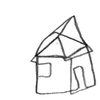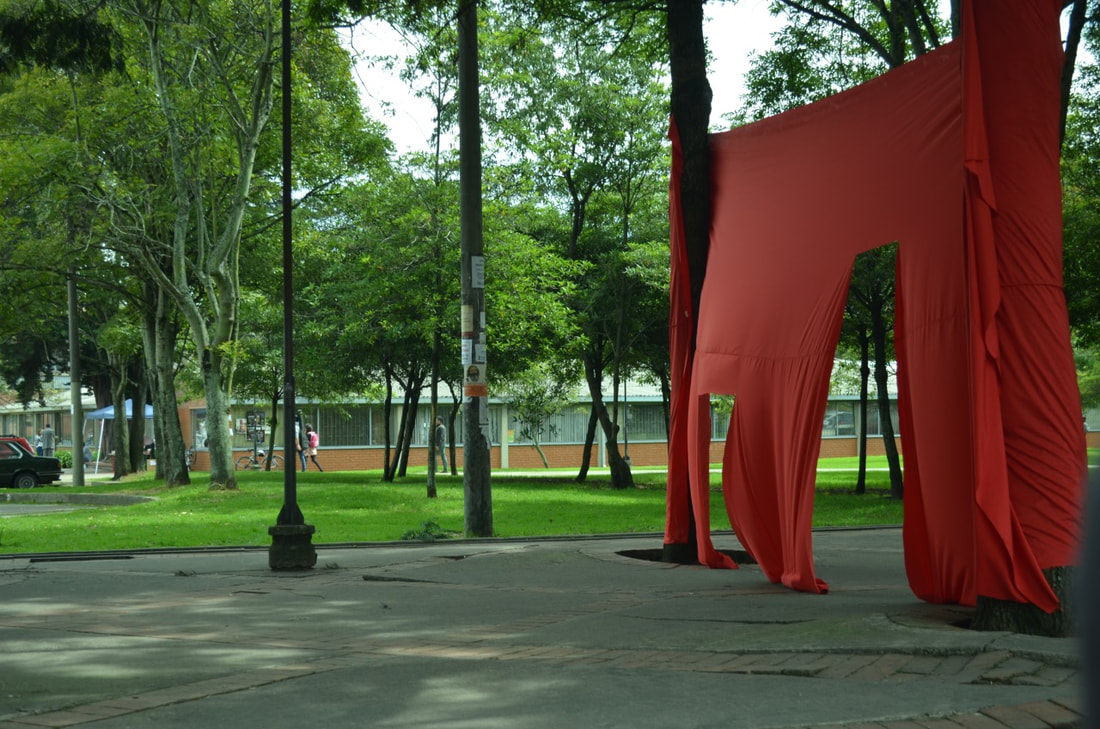Membrum Recurrere
Tela Roja / Red Fabric
3 m x 6 m
2014
Colaboración con / Cooperation with:
Sofia Londoño
Maira Montenegro
Ubicación / Location:
Universidad Nacional de Colombia
Bogotá
02 / 07 / 2014
8:00 am – 2:00pm
3 m x 6 m
2014
Colaboración con / Cooperation with:
Sofia Londoño
Maira Montenegro
Ubicación / Location:
Universidad Nacional de Colombia
Bogotá
02 / 07 / 2014
8:00 am – 2:00pm
Dentro de nuestra cotidianidad ¿Qué tan consientes somos de nuestro cuerpo?, ¿sabemos que llevamos encima?, ¿sentimos en qué lugar podemos caber y en cual no? Entendemos nuestro cuerpo en la intimidad, pero parece que al salir a la calle olvidamos que existe, solo lo conducimos hacia dónde queremos ir. El límite de nuestro cuerpo está en constante contacto con diversos límites y bordes; otros cuerpos, vivos e inertes. Límites lejanos, que solo podemos observar, y demasiado cercanos, que nos tocan.
Este proyecto tiene como propósito entender los límites del cuerpo que tengo, del cuerpo que cargo (maletas, chaquetas, bolsas, etc.). Y la relación con el espacio como límite. La puerta, el umbral, la salida o la entrada de un lugar son el mejor ejemplo para hablar de límite, es el borde de un espacio a otro; es una transición. Sin embargo, en la instalación es la abertura1 de un espacio al mismo espacio, ya que lo importante es la sensación del cuerpo al atravesar el umbral. Ser acariciado o evitar serlo, cambiar la postura del cuerpo. Contorsionarme, moverme para sentirme.
El cuerpo está allí solo debemos tener una dolencia para sentirlo o apreciarlo. Sentirlo cansado para tener consciencia de él. En el ser humano los movimientos mecánicos nos dejan divagar para tener en nuestra mente otros pensamientos. El acto de caminar es el más mecánico de todos, bajo la salvedad de los que no pueden y son conscientes de su cuerpo por esto. O de los que no saben y están aprendiendo.
Enfrentarse a un recorrido, es decir a un camino conocido, con un cuerpo conocido es algo muy común para todos. Sin embargo, es tan común que ya conocemos ese cuerpo espacio (camino), reconocemos sus huecos en el pavimento, los arboles alrededor, los charcos en los días lluviosos. Lo conocemos tan bien y nos sabemos mover con tanta familiaridad que cualquier cambio es notorio. La instalación de una tela roja de 6 m x 3 m es un límite bastante claro, sin embargo, no llega a ser una frontera, es una membrana.
Membrana esta primordialmente relacionado con la corporeidad, la carne. Es un filtro que deja pasar ciertas cosas, y retiene otras. Para que la membrana de 6 m x 3 m pueda ser denominada así, tiene dos umbrales, muy distintos en su forma, pero con una misma intensión, ser atravesados. La primera abertura es de 1,9 m x 0,4 m, no dista mucho de las medidas convencionales de una puerta, solo que es más angosta. Y el segundo portar es de 1,20 x 2 m, es mucho más bajo que una puerta habitual, pero es muy ancho. Estas medidas tienen la intensión de que el espectador cambie su postura, haciéndose consiente de su cuerpo, al atravesar la membrana.
Este proyecto tiene como propósito entender los límites del cuerpo que tengo, del cuerpo que cargo (maletas, chaquetas, bolsas, etc.). Y la relación con el espacio como límite. La puerta, el umbral, la salida o la entrada de un lugar son el mejor ejemplo para hablar de límite, es el borde de un espacio a otro; es una transición. Sin embargo, en la instalación es la abertura1 de un espacio al mismo espacio, ya que lo importante es la sensación del cuerpo al atravesar el umbral. Ser acariciado o evitar serlo, cambiar la postura del cuerpo. Contorsionarme, moverme para sentirme.
El cuerpo está allí solo debemos tener una dolencia para sentirlo o apreciarlo. Sentirlo cansado para tener consciencia de él. En el ser humano los movimientos mecánicos nos dejan divagar para tener en nuestra mente otros pensamientos. El acto de caminar es el más mecánico de todos, bajo la salvedad de los que no pueden y son conscientes de su cuerpo por esto. O de los que no saben y están aprendiendo.
Enfrentarse a un recorrido, es decir a un camino conocido, con un cuerpo conocido es algo muy común para todos. Sin embargo, es tan común que ya conocemos ese cuerpo espacio (camino), reconocemos sus huecos en el pavimento, los arboles alrededor, los charcos en los días lluviosos. Lo conocemos tan bien y nos sabemos mover con tanta familiaridad que cualquier cambio es notorio. La instalación de una tela roja de 6 m x 3 m es un límite bastante claro, sin embargo, no llega a ser una frontera, es una membrana.
Membrana esta primordialmente relacionado con la corporeidad, la carne. Es un filtro que deja pasar ciertas cosas, y retiene otras. Para que la membrana de 6 m x 3 m pueda ser denominada así, tiene dos umbrales, muy distintos en su forma, pero con una misma intensión, ser atravesados. La primera abertura es de 1,9 m x 0,4 m, no dista mucho de las medidas convencionales de una puerta, solo que es más angosta. Y el segundo portar es de 1,20 x 2 m, es mucho más bajo que una puerta habitual, pero es muy ancho. Estas medidas tienen la intensión de que el espectador cambie su postura, haciéndose consiente de su cuerpo, al atravesar la membrana.
In our daily life, how conscious are we of our body? Do we know what we have on us? Do we feel where we fit and not? We understand our body in its intimacy, but it seems that the moment we go out, we forget it exists, we simply drive it to the place we want to reach. The boundaries of our body are in constant contact with different limits and edges: other living and inert bodies. Remote limits, which we can just see, and too close limits, which touch us.
This project is intended to understand the boundaries of our body, the body we carry and wear (purses, bags, clothes, etc.) and the relation with the space as limit. The door, the threshold , the exit or the entrance of a place are the best example to talk about limits, it is the boundary form one space to the other; it is a transition. Nonetheless, in the installation, it is the opening1 from a space to the same space, because the sensation of the body going through this threshold is what really matters; being caressed or avoiding it, changing the posture of the body, contorting –moving for perceiving myself–.
The body is there, we just need to have a condition related to pain to feel it and appreciate it; perceiving it is tired so that we can be conscious of it. In the human being, mechanical movements allow us to wander so we can think about something else. The act of walking is the most mechanical one, except for those who cannot and are conscious about their bodies based on that, and those who are just learning.
Facing a route, i.e. a known path, with a known body is something common to everybody. It is so common that we already know that body space “path”, we recognise its potholes on the road surface, the surrounding trees, the puddles in the rainy days. We know all so well and we are so familiar with how to move that any change is evident. The installation of a red fabric of 6m x 3m is a pretty clear limit; however, it is not a frontier, it is a membrane.
Membrane is essentially related to the corporeality, the flesh. It is a filter lets go through certain things; it has two thresholds, very different in shape but sharing the same intention: piercing. The first opening measures 1,9m x 0,4m, which is not very different from the conventional measuring of a door; but it is narrower. And the second one measures 1,20m x 2m, which is lower than a typical door, but much wider. These measures attempt to force the spectator to change the posture, becoming conscious of their body when going through the membrane.
This project is intended to understand the boundaries of our body, the body we carry and wear (purses, bags, clothes, etc.) and the relation with the space as limit. The door, the threshold , the exit or the entrance of a place are the best example to talk about limits, it is the boundary form one space to the other; it is a transition. Nonetheless, in the installation, it is the opening1 from a space to the same space, because the sensation of the body going through this threshold is what really matters; being caressed or avoiding it, changing the posture of the body, contorting –moving for perceiving myself–.
The body is there, we just need to have a condition related to pain to feel it and appreciate it; perceiving it is tired so that we can be conscious of it. In the human being, mechanical movements allow us to wander so we can think about something else. The act of walking is the most mechanical one, except for those who cannot and are conscious about their bodies based on that, and those who are just learning.
Facing a route, i.e. a known path, with a known body is something common to everybody. It is so common that we already know that body space “path”, we recognise its potholes on the road surface, the surrounding trees, the puddles in the rainy days. We know all so well and we are so familiar with how to move that any change is evident. The installation of a red fabric of 6m x 3m is a pretty clear limit; however, it is not a frontier, it is a membrane.
Membrane is essentially related to the corporeality, the flesh. It is a filter lets go through certain things; it has two thresholds, very different in shape but sharing the same intention: piercing. The first opening measures 1,9m x 0,4m, which is not very different from the conventional measuring of a door; but it is narrower. And the second one measures 1,20m x 2m, which is lower than a typical door, but much wider. These measures attempt to force the spectator to change the posture, becoming conscious of their body when going through the membrane.

